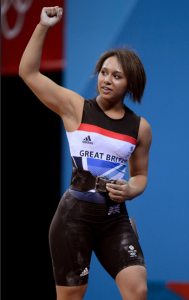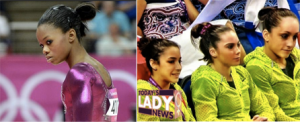August 9, 2012
By Emma Shakarshy
This Sunday the Olympic flame will be extinguished, marking the end of the 2012 summer Olympic Games in London. In addition to honoring and celebrating the achievements of all the Olympic athletes, the Closing Ceremony unites the world’s athletes who will march together as ‘one nation’. It’s been a rousing few weeks for so many nations who watched the dives, flips, throws, and hurtles with hope and anticipation. But unlike Olympics of years past, this year has been hailed, rightfully so, as the “Year of the Woman.” There is a lot to celebrate this year, for it marks the 40-year anniversary of Title IX, and the first year that all competing countries have sent women to the Olympic games. This is also the first year that women have competed in all events, with women’s boxing being the most recent addition to the women’s roster. Unfortunately, some people, especially those in the media have been taking “Year of the Woman” torch and blindly running with it.
Many feel that this year’s Olympics are a testament to gender equality on the track, in the pool, and on the mat. According to the Associated Press, Anita DeFrantz, chair of the International Olympic Committee Women and Sport has said, “I’m proud to say that the Olympic movement is living up to its own ideals of fair play and mutual respect”. But underneath the congratulatory hoopla, this year’s Olympics are a playing ground ripe with subtle, and not so subtle, gender inequities.
If you Google “female Olympians” the first sites that pop up are “12 Hottest Female Olympians of All Time”, Men’s Health’s “Sexiest Olympic
Athletes” spread, and a series of recent articles about gender discrimination in the 2012 games. A Google searcher would be hard pressed to find details of female Olympian’s athletic accomplishments. What we find are abs, legs and bikinis, but very few times, scores, and numbers. A search on Getty Images of Olympic beach volleyball turns up pictures of women from the waist down, focusing solely on women’s behinds. Unsurprisingly, this is not the case for most male sports.
It’s unfortunately not unusual to see female celebrities’ bodies being picked apart by the media. The “Who wore it best?” and “Before and After” type pieces have become staples of American culture, filling the pages of women’s fashion magazines. But the Olympics are not the Oscars and the Olympians are not walking down the red carpet. They are competing in high stakes athletic competitions. Despite the fact that their professions have very little to do with what they look like, female Olympians’ appearances strongly affect the prime time coverage they receive, the way they are portrayed by media outlets, and the type of sponsorships they do, or do not, receive.
Take, for example, Leisel Jones, the Australian swimming prodigy who first participated in the Olympic games when she was 14 years old. This year’s games will be her fourth, the most of any Australian swimmer in Olympic history. However, her athletic prowess did not stop the Herald Sun from creating a People Magazine style poll asking readers, based on then and now pictures of her, if she was “fit enough” to compete in the Olympic games. The Herald Sun had their own opinion, stating, “The Olympic veteran’s figure is in stark contrast to that of 2008.” And with that, the world’s focus shifted from her talents to the size of her thighs. Fellow Aussies, athletes, and feminist bloggers broke out their laptops and defended Jones via Twitter, but the damage was done.
Jones’ story is not an isolated incident and it is media coverage like the Sun’s that help make the Olympics a silent breeding ground for body shaming and physical pressures. Houston KHOU recently reported that one in five elite female athletes suffer from eating disorders. Olympic hurdler Damu Cherry Mitchell is quoted as saying, “I do have to watch what I eat. You have to look the part.” The Olympics is about more than how you perform. It is about how you look when you are performing. Triathlete Hollie Avil, a Beijing Olympian, has recently disclosed that she retired from elite sports after battling an eating disorder provoked by a coach’s comment regarding her weight. Rebecca Adlington, a swimmer on Britain’s Olympic team, told The Daily Telegraph this past week that she is going to avoid reading Twitter comments during the Games because so many of them are insults about her appearance.
Zoe Smith, British weightlifter, who broke the British weightlifting record was also harassed via Twitter about her weight and deemed a “lesbian”
and a “bloke” because of her sport. On her blog, Smith retorted, “The obvious choice of slander when talking about female weightlifting is ‘how unfeminine, girls shouldn’t be strong or have muscles, this is wrong’. And maybe they’re right… in the Victorian era”. Smith address the “chauvinistic, pigheaded blokes who feel emasculated by the fact that we, three small, fairly feminine girls, are stronger than them.” While it is remarkable that women will compete in all categories this year, the Olympic games clearly remain a hostile environment for women athletes.
This kind of appearance-focused media coverage is complicated by race, as well. While U.S. gymnast Gabby Douglas escaped commentary about her body, she has been the target of a great deal of criticism about her hair. Gabby wears her relaxed hair tied up in a bun on top of her head with gel and clips, like many other white gymnasts. But unlike many other gymnasts, the focus is not on her medals but on her “unkempt” hair and her “failure” to “represent” African American women. Yet again, this sort of “breaking news” is another distraction from a female athlete’s athletic talents.
In a statement to the Associated Press Gabby Douglas said, “What’s wrong with my hair?…I’m like, ‘I just made history and people are focused on my hair?’…You might as well just stop talking about it.”
Most of the pressure to “look the part” is associated with the potential sponsorships that come with the territory. That is…for some Olympians. While a select few women like runner Lolo Jones and swimmer Natalie Coughlin dominate our TV commercial breaks, women with “non-traditional” body types are conveniently pushed out of the public eye. Heavyweight lifter Sarah Robles, who is the U.S.’s best chance at the Olympic medal, was living on $400 a month and donated groceries to support herself until, after a ThinkProgress petition, she was picked up by one sponsor. She wasn’t signed by Adidas, Kelloggs, or Nike, but by Solve Media, a smaller web advertising company.
Robles told Buzzfeed, “You can get that sponsorship if you’re a super-built guy or a girl who looks good in a bikini. But not if you’re a girl who’s built like a guy”.
Male weightlifters often receive sponsors from diet pills and exercise equipment because many men want to look like male weightlifters. Despite Robles’ exceptional talent, because men and women have been socially conditioned to reject her body type, she faces incredible obstacles. Inspired by her own experiences in competitive sports, Robles created her own blog, Pretty Strong , a blog by and about strong women designed, “to encourage, support, and inspire the ladies out there busting their humps to be the best they can be”.
Sponsors seek out Olympians who are household names, but they are also the mechanisms that dictate who we talk about at the dinner table. Sponsors cited that it was not Robles’ body type but her lack of celebrity status that made her an unfavorable pick. It’s no wonder that the spotlight isn’t shining on Robles.
A study conducted by two UNC professors found that during the 2008 Olympics three quarters of the women’s Olympic coverage was devoted to gymnastics, swimming, diving, and beach volleyball. Co-authors Kelly Davis and C.A. Tuggle wrote, “Women who take part in sports that involve either power or hard-body contact are particularly unlikely to receive media coverage. When women engage in stereotypical feminine events, or look pretty or graceful, they will receive coverage, but they risk being shunned if they venture from that space.”
Despite the fact that women 18 and over were the largest viewing demographic, at the 2010 games, women received only 37.8% of prime time coverage. This creates a cycle: sports and body types that are not deemed socially acceptable are marginalized, thus limiting the public’s exposure to the majority of female Olympians. Sponsors then have little incentive to sponsor athletes like Robles and they are further stigmatized for the sports they perform and the bodies that got them to where they are.
These attempts to regulate women’s bodies are also evident in recent attempts to change the attire of female Olympians. While the first ever no bikini option in beach volleyball is receiving a lot of negative attention, little media attention has been paid to the Amateur International Boxing Association’s attempt to make the female boxers wear skirts instead of trunks “to differentiate them from men.” Gloria Peek, one of the US coaches responded, “The skirt equates to sex; it equates to nothing else. How are you going to take that and put it into a gladiator sport? And what does that have to do with it?” After a series of discussions, a compromise was made and skirts, while still very much on the table, are considered optional. A similar effort was made in badminton to attract fans, and resistance followed that attempt, as well. These efforts show that women playing their sports exceptionally is not enough. They must perform a certain type of femininity while excelling at their sport to be considered legitimate.
Despite the constant need for the media and our culture to distract from the true greatness of women, we have a lot to acknowledge and remember. Women’s boxing has it’s first champions, and the participation of Saudi Arabia’s first woman Olympic athlete marks great progress. But in addition to remembering how how far we’ve come, like the Olympians we admire, we have to persevere and push beyond the limits set on us to create a new record. We have a way to go, but together, we can effect change by raising awareness and starting these important conversations. It is the great achievements of these amazing athletes that should be celebrated, not their uniform size or the slickness of their ponytails. It’s crucial that as we watch this year’s Olympic season come to an end, we keep our eyes on the ball and like so many of the female athletes, not get distracted by the body obsession of our media driven culture.


